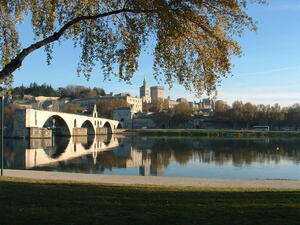When Popes were French in Avignon
How about visiting the Pope's private apartments this weekend? How about getting a glimpse of his bedroom and peeking into his study? We're not talking about the present Pope's residence in Rome, of course, but that of the "French Popes" who ruled over the Roman Catholic Church from Avignon between 1309 and 1378.
This week-end is Heritage Day in France, and like most historical monuments, the Palais des Papes in Avignon will be open for visits. It is an impressive construction, the largest "gothic palace" in the world—15,000 m²—and the most striking feature in the city's skyline.
This is the place were the Popes had their official residence for 70 years. The palace was erected in less than 20 years, between 1335 and 1352. Avignon's population at the time did not exceed 5,000 inhabitants. The presence of the Popes and their court boosted that number to 40,000, and transformed the somnolent provençal town into one of the largest European cities, a booming artistic and political metropolis.
The fact that the Holy See moved its residence to Avignon was the result of a political manoeuvre by French King Philippe IV le Bel (Phillip the Handsome), famous for having destroyed the Order of the Knights Templar and sentencing their Grand Master to death at the stake. Italy being restless and Rome being unsafe, King Philippe offered the newly elected Pope Clement V the hospitality of his kingdom. After several years of erring from convent to monastery, the Pope eventually settled in Avignon, close to land that had been bequeathed to the Holy See during the previous century.
Philippe's move was a smart one: for 70 years, all seven Avignon Popes would be French, as would 111 of the 134 cardinals elected during the period.
Avignon and the surrounding villages have retained a lot from their papal history: stunning religious architecture, several elegant cardinals' palaces, spectacular works of art and an atmosphere which, 700 hundred years after the official installation of Pope Clement V, still retains something of the majesty of 14th century papacy.



